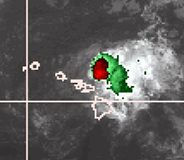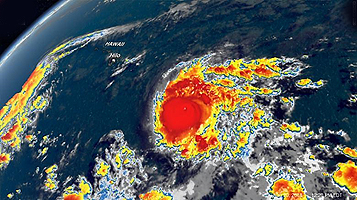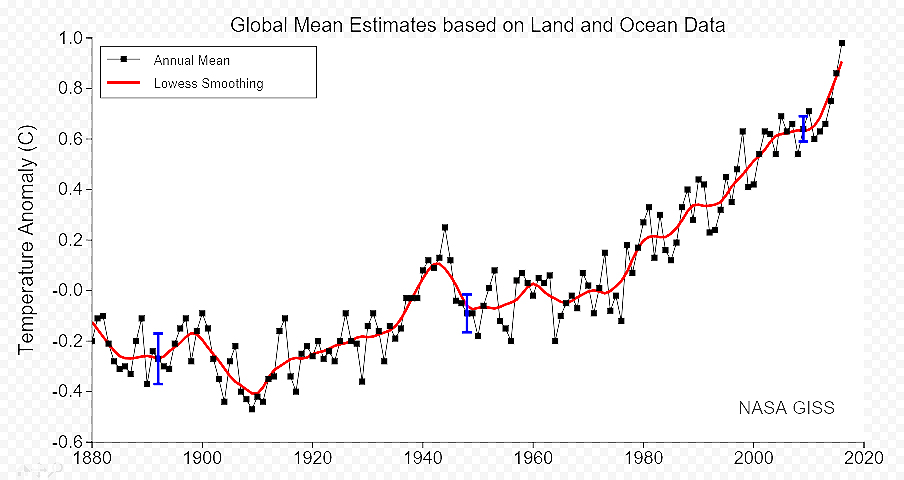The Cone of Uncertainty
Hawai’i Island Dodges A Bullet, As Tropical Storm (Olivia) Defies Worst Case Hurricane Expectations
— Final Update : Tuesday, Sept. 12. 2018, AM
Olivia, as of Wednesday morning, is no longer a Cat 1 Hurricane. Now, a much less powerful Tropical Storm, Olivia is presently moving west towards Maui at 12 mph and passing the Big Island farther to the north than originally forecast.  Olivia is still packing winds averaging 25-35 mph and remains a wind and flooding threat to islands north of Hawai’i Island.
Olivia is still packing winds averaging 25-35 mph and remains a wind and flooding threat to islands north of Hawai’i Island.
Future 2018 hurricane season threats for Hawai’i will encounter a strengthening El Nino (fueled by global warming emissions absorbed by the Earth’s oceans), and that is presently increasing water temperatures to significantly higher levels than is average throughout the island chain — in effect, providing the added fuel for supercharging future hurricanes.
Olivia, like Lane before it are the new storm norm – increasingly unpredictable, more powerful, and with the potential for greater destructive force, social, economic, and environmental impacts, and loss of life. “Because of the warm waters surrounding the islands this year, we may continue to see tropical storms and hurricanes maintain more strength as they approach Hawaii not only from the south, but also the east. If Olivia were to remain a hurricane when moving through the islands this would be something that has never happened,” according to AccuWeather (Sept. 10-2018).
Also, 2018-19 is now shaping up for a repeat performance by El Nino and for the Hawaiian Islands. Locally, this new ElNino event will likely add stress and new impacts to Hawai’i Island’s already impacted western reef system and coral, devastated by the El Nino event of 2015-16, that set unrepresented water temperature records linked to climate change, including ocean acidification: (http://www.noaa.gov/resource-collections/ocean-acidification).
originally published August 28th, 2018 —
Hurricane Lane, What it Revealed…
Hurricane Lane was a lesson in uncertainty for many of Hawaii’s residents, businesses, and vacationers looking for a good time in some form other than dodging the uncertainty of a slow moving and unpredictable Cat 5 hurricane.
How well prepared are our island country governments, the state as a whole, Hawaii’s residents and businesses, emergency responders for Lane-like hurricane results that at times seemed to defy traditional weather models and thinking?

With decades of scientific findings and experience, weather forecasting remains a hit and miss exercise for the public by failing to connect the dots between weather and climate change. Rising sea levels, unprecedented melting of the polar regions, a changing jet stream: all are connected to the arrival of 100 year storms occurring every 1 to 2 years. Rising global temperatures are also fueling extreme droughts, fires, flooding, storm intensity and duration, and changing the very nature of weather itself– all of which seemed far fetched in the not too recent past.
Global Warming, or as some call it, global weirding, explains a lot about how 21st century storms have changed and are continuing to change. Hurricane Lane turned into a Cat 5 monster, moving slower (at times less than 6 mph) than traditional storms through Hawai’i islands track. Today, storm tracking is less predictable, and storms are moving slower which is magnifying the duration and total rainfall released, along with increased wind speeds as the new norm.
Case in point, Hurricane Lane dumped an unprecedented amount of rain on what seemed like for Hilo area residents, rain for days on end. Hurricane Lane is the second wettest tropical cyclone to hit the United States, after Hurricane Harvey in 2017. In addition, Lane was the wettest tropical cyclone ever recorded in Hawaii, surpassing Hurricane Hiki of 1950. A maximum of 52.02 inches (1,321 mm) of rain was recorded at Mountainview, Hawaii on August 26. Hawaii Island’s famous Rainbow Falls resembled Niagara Falls from Lane’s unceasing rainfall, while the storm created unprecedented Big Island flooding problems.

Bring Science into Policy Decisions
Hurricane Lane is the latest example of how the traditional “cone of uncertainty” forecast models, still used to predict weather and hurricane tracks, are increasingly incomplete and uncertain as a public planning tool for all stakeholders. With all the technology available, an incomplete set of data parameters can only produce an incomplete picture for analysis and forecasting. Today’s weather forecasting tools largely ignore climate science and the veracity of scientific findings that help us better understand events now shaping our world’s weather and storm behavior.
Bigger, Stronger, Dangerous
Last year’s Hurricane Harvey produced record rainfall – Harvey was a 1,000-year flood event unprecedented in scale. More than 30 inches of rain fell over an area of 11,000 plus square miles) equivalent in size to the state of Maryland. Another 40 inches of rain from Harvey drenched an additional 3,400 square miles encompassing Texas and other gulf states.
Texas, which is accustomed to hurricanes and has the infrastructure needed to evacuate large quantities of storm water (unlike Hawai’i), but was totally unprepared for the flooding and destruction that Harvey delivered in 2017.
Hurricanes, like Harvey and Lane, and as others have shown that these thermodynamic storm systems can withdraw massive amounts of energy from the ocean and expel it into the atmosphere, all being fueled by warmer seas (the result of CO2 loading into the world’s oceans from unabated burning of fossil fuels). The warmer ocean temperature fuels storm intensity and supercharges higher winds, with slower storm tracks producing more intense rainfall by duration and amount (as was the case for Lane). The end result, a greater likelihood for destructive storm surges and coastal flooding amplified by raising sea levels.
The stunning combination of extreme strength and longevity supports the case for weather linkage to climate change, evidence that continues to grow with each new hurricane season.
Storms, Cause & Effect – What Can be Done
- Assumptions governing the design and development of water runoff must change, including: water catchment systems, cesspools, and municipal waste water management systems, roadways, bridges, residential and commercial buildings storm and water runoff management, etc. In short, past storm management assumptions must be updated to a new climate reality that now includes stronger and longer storm intensities with greater rainfall.
- Greater state and county resource response must be factored in budgeting processes and readiness. Our hats off to the impressive level of cooperation between government agencies and the private industries that help to keep the islands running during Hurricane Lane. But this remarkable response also came on backs of Federal, State, and County emergency resources already deployed in an on-going response to Kauai storm-related flooding and recent Kilauea eruption impacts on the Big Island. Clearly, an ongoing and coordinated effort at the state and county levels on emergency-response policy goals and implementation, prioritized to individual island needs is long overdue. — There is also the need for Hawai’i to address the individual differences and needs, island-by-island, for emergency preparedness, and storm impact mitigation. It is the latter that requires greater attention by state and local governments in producing an upgraded infrastructure and storm-hardening of critical systems. Needed are immediate infrastructure upgrades, including better waste and water management systems that address run-off intensity and flooding from supercharged and climate-fueled storm systems. All this will require reforming and aligning Hawaii’s building codes and infrastructure designed to meet the response needs of 21st century weather realities and challenges.
- Supply chain limitations of island living, combined with limited storage of essential supplies in the wake of and the aftermath of a major storm is another component of storm readiness. Increasingly, stronger storm events are producing longer term consequences for Hawaii’s social, economic, and environmental sectors. Distributed storage centers for supplies for each island (county) need to be readied to meet essential public supply needs for clean water, food and fuel and are ready to address supply needs beyond the current weekly supply-distribution cycles. If and when Oahu is the primary target of the next major Hurricane, by extension, the supply chain of which life in Hawai’i is dependent will likely be significantly disrupted, and with long term consequences. Hurricane Lane demonstrated just how lucky Hawai’i fared overall, because Oahu, and the state’s supply chain port hub Honolulu, dodged a bullet from this storm – less by planning and readiness, and more by luck and circumstances.
- Accelerate Hawaii’s transition to a clean energy economy. The electric grid and the power consumed represents the second largest contributor to global greenhouse gas emissions, just behind transportation. Global wind and solar developers took 40 years to install their first trillion watts of power generation capacity, and the next trillion may be finished within the next five years (source Bloomberg). Hawaii Electric, Hawaii’s primary electricity provider, must reform its current strategy of prolonging its supply chain dependency on imported dirty energy and on an Oahu-based centralized fuel refining, processing and distribution system in order to power its multi-island utility customer base. The HEI energy business model, dependent on fossil fuels, is fueling climate change, and by extension, impacts to Hawai’i. Solar and wind fuel replacement opportunities abound, and in combination with distributed residential and commercial solar installation coupled to localized battery storage options, microgrids — all together, clean energy technology is here — and the transition to a clean energy is cost effective enough for HEI to fully embrace a complete zero emissions power production and management capability, and one that will deliver greater grid reality against major storm events.
- Hawaii’s state legislature must immediately address the current deficiencies within the state’s Renewable Energy Portfolio standard which allows both dirty and clean energy replacement options of fossil fuels that allow for utilities to meet the state’s 2045 100% RPS goal with a mix of both emissions-laden and emissions-free energy replacement options of traditional imported fossil fuels.
Time is Not On Our Side
If a 100-year flood event occurs, that does NOT mean that people are ‘safe’ for 99 years. The risk of having the storm flooding in any given year is the same,” regardless of whether it occurred recently. Ditto for 500-year, and 1,000 year floods, as was the case with Hurricane Harvey in 2017. For the past 20 years, storm – climate linkage studies and modeling continue to be refined, but basic science and linkage data has been established. The current Federal Government Administration has demonstrated little interest in addressing the causes associated with global warming, in fact, this current Administration is deploying energy and environmental policies that accelerate the effects and impacts of burning more fossil fuels, not lessen them; fueling the fire of global warming.
As the climate warms (recent studies show), future hurricanes will not only be more powerful and destructive, but will likely occur both in and out of season — extending the Central Pacific Hurricane season threat into the late spring or late fall/early winter.
Hawai’i state, with its fragmented multi-island topography and separate county governments too often competing for state resources, cannot afford to continue to travel at a leisurely pace in developing and acting on policies designed to address the cause and effects of a new climate reality.
Nor can Hawai’i state expect a Federal Government bail-out from FEMA for all future major storm events. The trajectory for Federal FEMA funding and ability to respond is unsustainable as simultaneous super storm events and year-round fires impact mainland states. Hawai’i must proactively prepare through state, County, and private sector partnerships that are ready to address the storm mitigation needs of the state.
More must be done, and now. Recently, the state undertook a study on climate effects of sea level rise. The study focused on the potential impacts to Honolulu, Maui, and Kauai, largely ignoring the low lying and ocean facing vulnerabilities of Kona Airport, Hawaii island East and West port facilities, the downtown areas of Kailua and Hilo — all of which are at or near sea level and subject to storm surge and other related impacts, and increasingly so as time passes. A total state approach to planning and mitigation actions must be seriously undertaken.
The science of climate change is nearly 150 years old, tracing its roots back to the industrial age of the 19th century, when coal was king, and burning this dirtiest of fuels laid the foundation for today’s increasing global temperatures.
As uncertain as predicting weather is, even in the 21st century, and the current Administration’s de-funding and policy ignorance of climate science, leads us to one conclusion — Hawai’i cannot afford to be less prepared than is possible and practical in readying the state for the on-going impacts of climate change, with or without Federal assistance.
Global scientific efforts continue to evolve in both accuracy and validation, as scientists witness once a forecast, climate effects now unfolding — and now playing out in our lifetime.




Leave a Reply
Join the Community discussion now - your email address will not be published, remains secure and confidential. Mahalo.